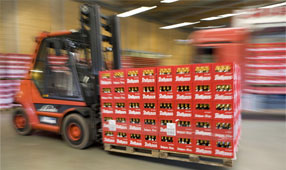Home » Tips & Advice » Forklift Capacity
Forklift Capacity
Forklift Service Agreement Options and Benefits

If you have ever shopped for forklifts before, you may have quickly realized that most manufacturers group vehicles by forklift capacity. Take top manufacturer Cat for example. Under the Cat lift truck category, Class I vehicles are available in different subcategories ranging from 2,500-10,000 pound capacity. Class IV vehicles are available from 3,000-15,500 pound capacity. Class V vehicles range from 3,000-36,000 pound capacity.
Clearly, forklift capacity can vary greatly from a lightweight truck to a heavy-duty vehicle. Understanding the importance of a forklift's capacity can help you to choose the best vehicle to meet your jobsite needs.
What is lift truck capacity?
It may make sense that if you regularly lift 3000 pound loads on-the-job, then a 3000 pound capacity forklift will do. But not so fast... Forklift weight limits are based on capacity ratings. These ratings may fluctuate and can be misinterpreted at face value.
Manufacturers agree that the load capacity of a forklift is the maximum amount of weight that it can safely transport on its load center. However, there is a catch - the gross capacity rating of a forklift is based on a set height when a forklift is operated in ideal conditions. When certain attachments are added, as they often are on-site, the safest lift capacity of a forklift will automatically change.
Other factors that may impact lift truck capacity include:
- Changes in load weight
- Changes in load length
Lift truck capacity ratings are generally based on a 24 inch load center in the truck. The industry capacity rating of a lift truck can be used to compare different forklift brands based on capacity.
Depending on the manufacturer, you may also find greater detail in forklift net, or payload, capacity. The net rating of a vehicle will account for a number of components that could affect load-bearing safety, including attachments, mast model, and mast height.
Factoring in forklift tire load capacity
Just when you thought you had it all figured out, forklift tire load capacity comes into play. Choosing the right tires will depend on the make and model of the forklift, as well as its load capacity. Slapping the wrong tires on a lift truck can directly reduce its lift capacity by affecting stability.
Fortunately, most lift trucks are classified with required tires, along with load capacity. For example, Cat Class I electric counterbalanced lift trucks are available with either pneumatic or cushion tires in the 3000-4000 pound load capacity. Heavy-duty electric counterbalanced trucks in the same class require a pneumatic tire at 7000-10,000 pound load capacity.
Buying the tire that matches your lift truck will support its load capacity. Tire selection should be based on manufacturer recommendations and operating conditions to uphold on-the-job safety.
Last of all, remember that tire capacity may vary by tire type. Amongst the basic categories of pneumatic, solid rubber, and polyurethane forklift tires, pneumatic tires are known to offer greater load capacity. For this reason, pneumatic tires are most often used in rugged settings to extend the life of a lift truck.
